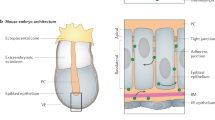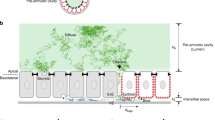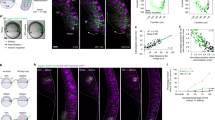Abstract
Forty years ago, it was proposed that during embryonic development and organogenesis, morphogen gradients provide positional information to the individual cells within a tissue leading to specific fate decisions1,2. Recently, much insight has been gained into how such morphogen gradients are formed and maintained; however, which cellular mechanisms govern their interpretation within target tissues remains debated3. Here we used in vivo fluorescence correlation spectroscopy and automated image analysis to assess the role of endocytic sorting dynamics on fibroblast growth factor 8 (Fgf8) morphogen gradient interpretation. By interfering with the function of the ubiquitin ligase Cbl, we found an expanded range of Fgf target gene expression and a delay of Fgf8 lysosomal transport. However, the extracellular Fgf8 morphogen gradient remained unchanged, indicating that the observed signalling changes are due to altered gradient interpretation. We propose that regulation of morphogen signalling activity through endocytic sorting allows fast feedback-induced changes in gradient interpretation during the establishment of complex patterns.
This is a preview of subscription content, access via your institution
Access options
Subscribe to this journal
Receive 12 print issues and online access
$209.00 per year
only $17.42 per issue
Buy this article
- Purchase on Springer Link
- Instant access to full article PDF
Prices may be subject to local taxes which are calculated during checkout





Similar content being viewed by others
References
Tabata, T. & Takei, Y. Morphogens, their identification and regulation. Development 131, 703–712 (2004).
Wolpert, L. Positional information and the spatial pattern of cellular differentiation. J. Theor. Biol. 25, 1–47 (1969).
Jaeger, J., Irons, D. & Monk, N. Regulative feedback in pattern formation: towards a general relativistic theory of positional information. Development 135, 3175–3183 (2008).
Reifers, F. et al. Fgf8 is mutated in zebrafish acerebellar (ace) mutants and is required for maintenance of midbrain-hindbrain boundary development and somitogenesis. Development 125, 2381–2395 (1998).
Reifers, F., Walsh, E. C., Leger, S., Stainier, D. Y. & Brand, M. Induction and differentiation of the zebrafish heart requires fibroblast growth factor 8 (fgf8/acerebellar). Development 127, 225–235 (2000).
Raible, F. & Brand, M. Tight transcriptional control of the ETS domain factors Erm and Pea3 by Fgf signaling during early zebrafish development. Mech. Dev. 107, 105–117 (2001).
Crossley, P. H., Minowada, G., MacArthur, C. A. & Martin, G. R. Roles for FGF8 in the induction, initiation, and maintenance of chick limb development. Cell 84, 127–136 (1996).
Leger, S. & Brand, M. Fgf8 and Fgf3 are required for zebrafish ear placode induction, maintenance and inner ear patterning. Mech. Dev. 119, 91–108 (2002).
Scholpp, S. & Brand, M. Endocytosis controls spreading and effective signaling range of Fgf8 protein. Curr. Biol. 14, 1834–1841 (2004).
Yu, S. R. et al. Fgf8 morphogen gradient forms by a source-sink mechanism with freely diffusing molecules. Nature 461, 533–536 (2009).
Piddini, E. & Vincent, J. P. Interpretation of the wingless gradient requires signaling-induced self-inhibition. Cell 136, 296–307 (2009).
Dessaud, E. et al. Interpretation of the sonic hedgehog morphogen gradient by a temporal adaptation mechanism. Nature 450, 717–720 (2007).
Jullien, J. & Gurdon, J. Morphogen gradient interpretation by a regulated trafficking step during ligand–receptor transduction. Genes Dev. (2005).
Eswarakumar, V. P., Lax, I. & Schlessinger, J. Cellular signaling by fibroblast growth factor receptors. Cytokine Growth Factor Rev. 16, 139–149 (2005).
Dikic, I. & Giordano, S. Negative receptor signalling. Curr. Opin. Cell Biol. 15, 128–135 (2003).
Haugsten, E. M., Malecki, J., Bjorklund, S. M., Olsnes, S. & Wesche, J. Ubiquitination of fibroblast growth factor receptor 1 is required for its intracellular sorting but not for its endocytosis. Mol. Biol. Cell 19, 3390–3403 (2008).
Huang, F., Goh, L. K. & Sorkin, A. EGF receptor ubiquitination is not necessary for its internalization. Proc. Natl Acad. Sci. USA 104, 16904–16909 (2007).
Soubeyran, P., Kowanetz, K., Szymkiewicz, I., Langdon, W. Y. & Dikic, I. Cbl-CIN85-endophilin complex mediates ligand-induced downregulation of EGF receptors. Nature 416, 183–187 (2002).
Nau, M. M. & Lipkowitz, S. Comparative genomic organization of the cbl genes. Gene 308, 103–113 (2003).
Kassenbrock, C. K. & Anderson, S. M. Regulation of ubiquitin protein ligase activity in c-Cbl by phosphorylation-induced conformational change and constitutive activation by tyrosine to glutamate point mutations. J. Biol. Chem. 279, 28017–28027 (2004).
Levkowitz, G. et al. Ubiquitin ligase activity and tyrosine phosphorylation underlie suppression of growth factor signaling by c-Cbl/Sli-1. Mol. Cell 4, 1029–1040 (1999).
Rink, J., Ghigo, E., Kalaidzidis, Y. & Zerial, M. Rab conversion as a mechanism of progression from early to late endosomes. Cell 122, 735–749 (2005).
Haugsten, E. M., Sorensen, V., Brech, A., Olsnes, S. & Wesche, J. Different intracellular trafficking of FGF1 endocytosed by the four homologous FGF receptors. J. Cell Sci. 118, 3869–3881 (2005).
Zerial, M. & McBride, H. Rab proteins as membrane organizers. Nat. Rev. Mol. Cell Biol. 2, 107–117 (2001).
Pelkmans, L. & Zerial, M. Kinase-regulated quantal assemblies and kiss-and-run recycling of caveolae. Nature 436, 128–133 (2005).
Rohner, N. et al. Duplication of fgfr1 permits Fgf signaling to serve as a target for selection during domestication. Curr. Biol. 19, 1642–1647 (2009).
Schlessinger, J. Common and distinct elements in cellular signaling via EGF and FGF receptors. Science 306, 1506–1507 (2004).
Ryan, P. E., Davies, G. C., Nau, M. M. & Lipkowitz, S. Regulating the regulator: negative regulation of Cbl ubiquitin ligases. Trends Biochem. Sci. 31, 79–88 (2006).
Bao, J., Gur, G. & Yarden, Y. Src promotes destruction of c-Cbl: implications for oncogenic synergy between Src and growth factor receptors. Proc. Natl Acad. Sci. USA 100, 2438–2443 (2003).
Nahmad, M. & Stathopoulos, A. Dynamic interpretation of hedgehog signaling in the Drosophila wing disc. PLoS Biol. 7, e1000202 (2009).
Amaya, E., Stein, P. A., Musci, T. J. & Kirschner, M. W. FGF signalling in the early specification of mesoderm in Xenopus. Development 118, 477–487 (1993).
Ulrich, F. et al. Wnt11 functions in gastrulation by controlling cell cohesion through Rab5c and E-cadherin. Dev. Cell 9, 555–564 (2005).
MacArthur, C. A. et al. FGF-8 isoforms activate receptor splice forms that are expressed in mesenchymal regions of mouse development. Development 121, 3603–3613 (1995).
Acknowledgements
We thank members of the Brand and M. Zerial laboratories for stimulating discussions; C. Boekel, C. P. Heisenberg and M. McShane for critical comments on the manuscript; M. Fischer and K. Sipple for fish care; and P. Schwille and the Biotec/CRTD imaging facility for technical advice. This work was supported by an HFSP network grant (050503-50) and by the EU Endotrack grant (050503-52) to M.B.
Author information
Authors and Affiliations
Contributions
M.N., S.R.Y., M.G. and A.M. carried out experiments. M.N., S.R.Y. and M.B. analysed the data. M.N. and M.B. designed the project and wrote the paper.
Corresponding author
Ethics declarations
Competing interests
The authors declare no competing financial interests.
Supplementary information
Supplementary Information
Supplementary Information (PDF 1237 kb)
Rights and permissions
About this article
Cite this article
Nowak, M., Machate, A., Yu, S. et al. Interpretation of the FGF8 morphogen gradient is regulated by endocytic trafficking. Nat Cell Biol 13, 153–158 (2011). https://doi.org/10.1038/ncb2155
Received:
Accepted:
Published:
Issue Date:
DOI: https://doi.org/10.1038/ncb2155
This article is cited by
-
Current capabilities and future perspectives of FCS: super-resolution microscopy, machine learning, and in vivo applications
Communications Biology (2023)
-
Consensus Paper: Cerebellar Development
The Cerebellum (2016)
-
Nedd4-1 binds and ubiquitylates activated FGFR1 to control its endocytosis and function
The EMBO Journal (2011)
-
Regulation of developmental intercellular signalling by intracellular trafficking
The EMBO Journal (2011)



